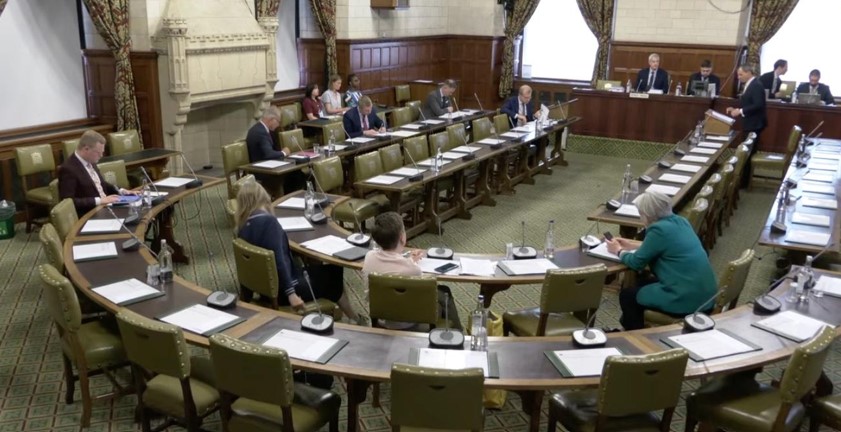The practice of hydraulic fracturing (fracking) has taken center stage this year as one of the most important environmental threats facing North America (and increasingly in other parts of the world). Thanks to inadequate state oversight and Dick Cheney’s hamstringing of EPA oversight with the Halliburton Loophole, fracking has expanded through the United States incredibly rapidly over the past few years. In 2011, fracking faced much closer scrutiny as scientists, researchers and affected communities continue studying water, air and property impacts reported in areas where the controversial unconventional energy drilling is taking place.
Fracking awareness received a huge boost this year with “Gasland,” a documentary film which earned director Josh Fox an Academy Award nomination. Featuring interviews with landowners and families affected by fracking, the film is helping to bring the issue to the mainstream.
DeSmogBlog has published dozens of posts detailing the latest information available on fracking over the several years.
In May 2010, DeSmogBlog released an extensive report, Fracking The Future: How Unconventional Gas Threatens Water, Health, and Climate, delving into many of the health, environmental and climate threats posed by the fracking boom.
Here is a small sample of important fracking coverage this year from DeSmog and other outlets:
An excerpt from Fracking The Future:
Since the Reagan era, those charged with protecting health and the environment have instead worked with the gas industry to minimize public awareness of its practices, and to hide the early warning signs regarding the inherent dangers of drilling deeper into the Earth for fossil fuels. State agencies have been pressured to accommodate the industry’s increasingly dangerous drilling techniques, and have largely enabled the poor, unmonitored practices common in the industry today.
The gas industry is investing millions of dollars each year to restrict oversight to the state level and thwart all federal involvement. The number of gas industry lobbyists has increased seven-fold in recent years, exhibiting the dangerous political sway the dirty energy industry exercises in Washington and at the local level across the nation.
Industry front groups like Energy in Depth (EID) play a pivotal role in the dissemination of misinformation and efforts to attack and silence those who attempt to call polluters to account.
ProPublica reported on the link between fracking and infamous “flammable drinking water”:
A new peer-reviewed study from Duke University shows that drinking water in areas within a half-mile of fracking wells can become contaminated with dangerous levels of methane – enough to catch on fire if lit. The report says that the levels of methane in some areas of Pennsylvania and New York are so great that they pose a significant fire and explosion hazard.
Fracking linked to groundwater contamination:
The EPA found that fluid from a shale gas well more than 4,000 feet deep contaminated well water and that the incident was “illustrative” of pollution problems associated with oil and gas drilling. With now-uncharacteristic candor, the EPA report outlines how the contamination occurs: “During the fracturing process…fractures can be produced, allowing migration of native brine, fracturing fluid and hydrocarbons from the oil or gas well to a nearby water well. When this happens, the water well can be permanently damaged and a new well must be drilled or an alternative source of drinking water found.”
More on groundwater contamination:
The tables turned on the gas industry today with the release of a new report by the Environmental Protection Agency (EPA) connecting the dots between fracking and groundwater contamination in the state of Wyoming, located in the heart of the Niobrara Shale basin.
The report is sure to leave many saying, “Well, duh!” and also asking, “What took them so long?” The perils of fracking for gas in the Niobrara Shale were made famous long ago by Debra Anderson’s documenary “Split Estate.”
The Wyoming report comes on the heels of a large citizen action involving a water delivery to 12 Dimock, Pennsylvania families, led by “Gasland” Director Josh Fox and actor Mark Ruffalo. The action centered around another case of water contaminated by Cabot Oil and Gas. Cabot was delivering clean drinking water since 2008 to the families after it contaminated their water, but recently, the Pennsylvania DEP ordered that Cabot was no longer responsible for transporting water to these families.
Fracking has even been linked to earthquakes in the U.S. and the U.K.:
New reports are surfacing that link fracking to earthquakes that occurred in January in Oklahoma. According to a new study by the Oklahoma Geological Survey [PDF], fracking is linked to 50 mini-earthquakes that occurred on January 18, 2011 in Oklahoma.
The occurrence of so-called “induced seismicity” – seismic activity caused by human actions – in conjunction with fluid injection or extraction operations is a well-documented phenomenon. However, induced earthquakes large enough to be felt at the surface have typically been associated with large scale injection or withdrawal of fluids, such as water injection wells, geothermal energy production, and oil and gas production. It was generally thought that the risk of inducing large earthquakes through hydraulic fracturing was very low, because of the comparatively small volumes of fluid injected and relatively short time-frame over which it occurs. As the controversy over hydraulic fracturing has heated up, however, researchers and the public have become increasingly interested in the potential for fracking to cause large earthquakes.
But this is hardly a new phenomenon. Studies show that fracking practices in the 1970s had caused similar seismic activity in Oklahoma, according to E&E News.
So, with all of the health, environmental, climate and even seismic threats posed by fracking, why hasn’t the federal government stepped in with a national moratorium until these impacts can be assessed by scientists?
The answer is simple: Dirty Money. DeSmogBlog has followed the industry money trail all year, and here is what we’ve found:
Pennsylvania, a hotbed for fracking activities, has been flooded with dirty energy industry money:
The gas industry spent $3.5 million last year attempting to convince Pennsylvania lawmakers of the benefits of drilling the state’s deposits of unconventional gas. According to lobbying disclosure reports filed with the Department of State, the lobbying blitz to influence public policy was orchestrated by a collection of 22 companies, the Marcellus Shale Coalition (MSC) and the Pennsylvania Independent Oil and Gas Association (PIOGA).
The increasing lobbying activity in Pennsylvania demonstrates the industry’s continued efforts to expand unconventional drilling, despite growing public concern over the inherent risks of dirty fracked gas. The oil and gas industry is focusing its efforts primarily on confusing the public and influencing politicians, not on making their operations safe for public health and the environment.
New York State was also under attack from a barrage of corporate polluter cash:
Those who were wondering the motive behind NY Democratic Governor Anthony Cuomo’s decision to lift New York’s moratorium on fracking now have a better sense for his enthusiasm: campaign cash.
Companies that drill for natural gas have spent more than $3.2 million lobbying state government since the beginning of last year, according to a review of public records. The broader natural gas industry has been giving hundreds of thousands of dollars to the campaign accounts of lawmakers and the governor…The companies and industry groups have donated more than $430,000 to New York candidates and political parties, including over $106,000 to Mr. Cuomo, since the beginning of last year.
State governments weren’t the only to be influenced by fracking cash – the federal government, all the way up to the top of the Executive Branch, found that companies with a financial interest in fracking can be quite generous:
In an under-reported move on May 5th, the Obama administration announced the members of a government panel created to study the practice of hydraulic fracturing (fracking), and determine if there are ways, or even a necessity, to make it safer for the environment and public health. Unfortunately, according to a report by the Environmental Working Group (EWG), the administration stacked the panel with oil and gas industry insiders.
The panel, handpicked by Secretary of Energy Steven Chu, is directed to investigate the safety of shale gas development and to make recommendations for both improvements to the process as well as ‘best practice’ strategies that can act as recommendations to relevant agencies.
Scientists from 22 universities in 13 states voiced their concerns over the partiality of the panel, which they claim is “performing advocacy-based science.” As the letter outlines, 6 of the 7 panel members still have strong financial ties to the oil and gas industry, like the panel chairman John Deutch, who received more than $1.4 million from two leading gas companies, Chinere and Slumberger between 2006 and 2009 alone. Deutch currently sits on the board of directors at Chinere.
As such, the group worries that the panel will in fact “serve industry at taxpayer expense rather than serving President Obama and the public with credible advice.”
Alternet’s Scott Thill has laid out the financial issues, as well:
Thanks to the United States’ morally bankrupt political system and its Supreme Court’s reality-defying ruling on Citizens United v. Federal Election Commission, the fracking lobby’s power of the purse is greater than it has ever been.
That power was depressingly dissected in Common Cause’s recent report, Deep Drilling, Deep Pockets, which explained that earnings junkies like Exxon, Koch and more have paid House and Senate politicians on select energy and commerce committees nearly $750 million over the last decade to smother regulatory oversight of the expanding fracking practice, whose complete chemical components still remain a relative mystery. It was evidently money well spent. During that lobbying stretch, the Environmental Protection Agency scientifically linked fracking with water poisoning in Wyoming, and probably isn’t far from siding with the increasing ranks of those who blame fracking for earthquakes from Oklahoma to Ohio to England. And yet beyond manageable fines and stock devaluations, no one from the industry has yet to seriously face the music for groundwater contamination and worse.
For that, you can thank the industry’s “Halliburton loophole,” so named for former Vice-President Dick Cheney’s insistence that his former company’s fracking be stripped of EPA regulation. Years and billions later, money still talks and safety still walks in our peak oil century tapping, like veins, what fossil fuel deposits we have left, from natural gas to tar sands. And they do so in a decidedly nonpartisan fashion.
Buying political favors is just what the public knows about – stuff that the industry isn’t trying to hide. It’s the tactics that the public didn’t necessarily know about that really make you cringe.
Excerpt from Gas Fracking Industry Using Military Psychological Warfare Tactics and Personnel In U.S. Communities:
At the “Media & Stakeholder Relations: Hydraulic Fracturing Initiative 2011” conference in Houston, Matt Pitzarella, Director of Corporate Communications and Public Affairs at Range Resources, revealed in his presentation that Range has hired Army and Marine veterans with combat experience in psychological warfare to influence communities in which Range drills for gas.
At that same conference, Matt Carmichael, External Affairs Manager at Anadarko Petroleum Corporation, suggested three things to attendees during his presentation:
“If you are a PR representative in this industry in this room today, I recommend you do three things. These are three things that I’ve read recently that are pretty interesting.
“(1) Download the U.S. Army/Marine Corps Counterinsurgency Manual [audible gasps from the audience], because we are dealing with an insurgency. There’s a lot of good lessons in there, and coming from a military background, I found the insight in that extremely remarkable.
The Counterinsurgency (COIN) Field Manual [PDF] devotes an entire chapter to PSYOPs, confirming its utility as a major element of a counterinsurgency campaign. The COIN manual is the current U.S. military doctrine in both Iraq and Afghanistan.
PSYOPs is the military short-hand for “psychological operations,” used extensively in U.S. wars abroad, including in Iraq and Afghanistan. Much of this work is carried out by Army reserve personnel, who travel from village to village dropping leaflets and offering financial incentives in an attempt to convince residents not to support the insurgency. This often entails using psychological tactics to “win hearts and minds.”
Read that full story: Gas Fracking Industry Using Military Psychological Warfare Tactics and Personnel In U.S. Communities
In addition to reporting on the disturbing use of psy-ops by the fracking industry, Brendan DeMelle helped expose the lies of fracking proponents by dissecting the industry talking points on fracking.
There were a few positive stories this year with regards to fracking:
Big news erupted across the Northeast with an announcement that fracking in the Delaware River Basin, a pristine watershed that supplies water to over 15 million people, would be suspended. The Delaware River Basin Commission was set to vote on whether or not to permit 20,000 fracking wells in the area on Monday, November 15th. However after enormous citizen backlash, the DRBC realized they did not have the votes to push the practice through.
The U.S. EPA is poised to enact the first ever rules on hydraulic fracturing (fracking) with a proposal that would allow the agency to regulate the practice under the Clean Air Act. The Clean Air route was chosen by the agency, as the U.S. Congress prohibited their attempts to regulate the practice of fracking under the Clean Water Act in 2005.
Once the EPA sets a date for implementation, the gas industry will have 60 days to submit any complaints or input on the new rules. While the date is not currently set, the American Petroleum Institute has already asked the EPA to delay implementation until at least August 2012.
For more on the villains and heroes in this year’s fracking bonanza, check out this report from Food and Water Watch.
The battle to protect our environment and personal health from the harmful impacts of fracking is just beginning. But as long as public awareness continues to grow and communities continue speaking out against dirty reckless fuels, perhaps common sense will prevail and we can turn our sights toward developing a clean energy future.
Subscribe to our newsletter
Stay up to date with DeSmog news and alerts







